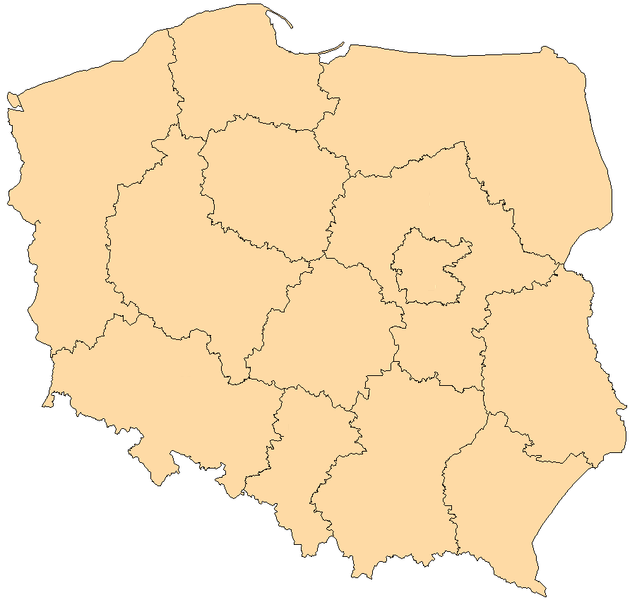
Poland first elected MEPs in 2004, when they elected 54 MEPs. In 2009 they will elect 50 MEPs across thirteen constituencies, with each constituency electing between one and eight MEPs in 2004. Seats are allocated by proportional representation to parties that win at least 5% of the national vote. The first map shows the map of Poland’s constituencies.
The 2004 election saw the following parties win seats:
- Civic Platform (PO – European People’s Party) – 15
- League of Polish Families (LPR – Independence and Democracy) – 10
- Law and Justice (PiS – UEN) – 7
- Self-Defense of the Republic of Poland (SoRP – UEN/PES) – 6
- Democratic Left Alliance-Labor Union (SLD-UP – Party of European Socialists) – 5
- Freedom Union (UW – European Liberal Democrat and Reform Party) – 4
- Polish People’s Party (PSL – EPP) – 4
- Social Democracy of Poland (SDPL – PES) – 3
Polish politics shifts rapidly. The old Solidarity movement ruled until the 2001 election, when it lost all parliamentary representation, and at the time of the 2004 election, Democratic Left Alliance-Labor Union had a solid majority in the Parliament were in a minority government.
Since the 2004 election, the 2005 election was won by the far-right Law and Justice party, who led a conservative coalition. This coalition collapsed in 2007 and the opposition liberal conservative Civic Platform party formed government, with the support of fellow EPP affiliate Polish People’s Party.
League of Polish Families, who came second in the 2004 election, failed to pass the threshold at the 2007 parliamentary election, and do not seem to be standing in this year’s election. Recent polls have Civic Platform well in front, polling just below 50%. Law and Justice has been polling in the 20-25% range, while Democratic Left Alliance is sitting on 8-12%. The result seems likely to reinforce the current major parties.



Polish politics does indeed shift very rapidly. If you take a timeframe of 5 years since 1989, you find that the general makeup of parties and government is very different to that of 5 yrs before. No government has won reelection since the first completely free legislative elections of 1991. 1991-1993 had a plethora of parties elected to the parliament (some with only 1-2% of the vote). The result was total chaos, so a threshold of 5% was instituted prior to the 1993 elections, and these were won by the Democratic Left Alliance (ex-Communist, but if fact in terms of policy, much like the Australian Labor Party, and the major centre left parties of Europe generally). They formed govt. with the Polish Peoples Party (an agrarian party). These two parties are the only major parties from the 1991 era, who are still prospering today. The history of Polish politics from 1989-2005 can be summarized as being a battle between the ex-Communist left and the post-Solidarity right. The left was more stable during this period but the post-Solidarity right managed to win government 1991-1993 and 1997-2001. There is also a distinction between the Solidarity party itself (under various names, such as AWS – Solidarity Electoral Action) and the post-Solidarity parties (such as the Freedom Union (today’s small Democratic Party), Civic Platform or Law and Justice). These latter parties also regard themselves as heirs to the Solidarity tradition, and have many high profile ex-Solidarity figures in their ranks.
Since 2005, the political landscape has shifted significantly. It’s no longer so much about ex-Solidarity vs ex-Communist, as tradition and security (Law and Justice) vs the free market, closer EU integration and modernization (Civic Platform). The Polish political scene since 2005, could be dubbed the “Tusk/Kaczynski era”, with PM Donald Tusk and his Civic Platform in constant battle with the Kaczynski brothers and the Law and Justice party (ie. President Lech Kaczynski and his brother Jaroslaw (chairman of Law and Justice, and ex-PM)). It is expected that Tusk will take on Lech Kaczynski again in the Presidential elections of 2010 (having lost in 2005), and Tusk is the favourite to win.
This will be only Poland’s second EU election. I expect, that as the opinion polls state, Civic Platform will win a plurality or even a majority of seats. The interesting thing about Polish election data is that if you look at the opinion polls, there doesn’t seem to be much difference in voter party support for EU elections as compared to polling data for Polish national elections. In many other EU countries, voters would vote fairly differently in national elections than they would in EU elections.
Ben – one point I would make re your intro, which is a good summary. The Democratic Left Alliance-Labour Union did not have a majority in 2004. They won a plurality of seats at the 2001 election, and formed a majority govt. with the Polish People’s Party. However this coalition broke down in 2003, and so a minority govt. prevailed until the 2005 elections. No party has ever won a majority of seats in Polish elections to date. Also, as regards the League of Polish Families, they will be contesting the elections on the ticket of the anti-EU Libertas Party.
Ah, I confused the 2001 results with the Senate results, where they did win a large majority.
Poland uses plurality bloc voting for the Senate, which produces a very different outcome in the upper house. The distortionate results of the system, means that the biggest party normally controls the Senate, after the election.
Comments are closed.